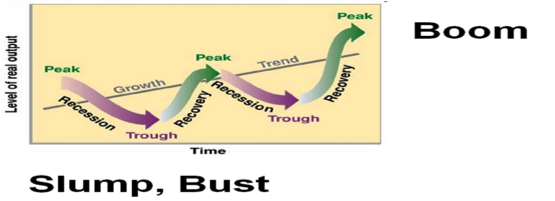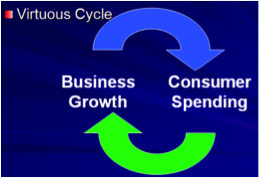Possible Macroeconomic Objectives
Recap: What is an Economy?
The production and consumption of goods and services in a country.
What is economic growth?
When a country’s Gross Domestic Product (GDP – total value of output of goods and services in a country in a year) increases.
Mixed Economies are common! Therefore in most countries in the world the government has some sort of influence in business.
-
How can the benefits of business activity be encouraged whilst controlling or stopping the undesirable effects?
-
The answer is changes in the government policy (next lesson).
-
Governments try to control business for the benefit of all society and stakeholders – consumers, workers, local residents and the whole community.
Gross __Domestic__product (GDP) is defined as “the value of all final goods and services produced in a country in 1 year”.
Gross National Product (GNP) is defined as “the market value of all goods and services produced in one year by residents of a country.”
4 key macroeconomic objectives of any government are the following:
Here comes lots of questions to recap on what you have learnt so far. Type or write out your answers comprehensively. When you have answered, compare your answers against the Key Concepts in 2.6.1 – Possible Macroeconomic Objectives (Extension).
Questions: High Economic Growth
Question 1: It is important that the economic growth is sustainable. What would happen if it was unsustainable growth? Clue: rapid inflation in China.
Question 2: If the economy is growing too fast, how does this lead to demand pull inflation?
Question 3: How does economic growth lead to higher living standards? Clue – disposable income.
__Question 4: __ Current government policy priority is sustainable economy growth, low unemployment and stabilised inflation, with a favourable current account not prioritised. How are the current gov doing in regards to these 4 key macroeconomic objectives? Research recent figures and make a judgment.
Questions: Low Unemployment
__Question 1: ___Why are low levels of unemployment needed to maximise output in order to achieve economic growth? _Clue: productivity/capacity utilisation/tax revenues.
__Question 2: __ What is ‘full employment’ and how can it be achieved?? How can attaining ‘full employment’ increase economic growth?
___Question 3: ___What is underemployment and how has zero hour contracts increased it in the post GFC years? How can reducing ‘underemployment’ help increase economic growth?
__Question 4: __ Why is low unemployment both a ‘desirable social and political goal’? What are the benefits to society of low unemployment? What are the political benefits?
Questions: Low and Relatively Stable Rates of Inflation
___Question 1: ___How does low/stable rates of inflation contribute to economic and political stability?
Question 2: Target is 2%, a positive figure. Why is a 2% increase in average prices a sign of a healthy economy? Clue: demand pull inflation!
__Question 3: __‘Zero inflation is not the target, it is uncomfortably close to deflation’. What is deflation and why does it work against the macroeconomic objectives of economic growth and higher unemployment. Clue: Japan in the 90s/00s.
__Question 4: __ ‘Minor disadvantages of a 2% increase in inflation are thought to be outweighed by the benefits of relative stability’ – who are the losers with inflation? Clue: review 2.5.3; fixed incomes/savers.
Questions: Balance of Payments Equilibrium on Current Account
___Question 1: ___What are the 3 core components of the UK current account?
Question 2: Recent governments have chosen not to make attaining an equilibrium (current outflows = current inflows) a priority, why?_ Clue: ‘juggling balls’ concept and our historic trade deficit._
Question 3: If imports > exports a trade deficit occurs and money flows out from our economy to other economies. If this is private sector money it is ok, but if it is financed by borrowing and grows unsustainably this could be a threat to our economy. How? (clue – GFC and banking crash!).
Question 4: If inflation was suddenly to accelerate, UK products would become less competitive. Why? And how would this affect the balance of trade?
Question 5: If we have a deficit on all 3 core components, how does this affect our exchange rate? (clue – excess supply of sterling(£) to buy imports and falling demand for sterling due to lack of exports will do what to a D&S diagram?? What are the opportunities/threats of a WPIDEC scenario?)
Key Concepts
Key Concepts: High Economic Growth
__Question 1: __ If aggregate demand grows too unsustainably fast then there would be rapid inflation which would cause uncertainty amongst business and customers and therefore a very rapid contraction in AD as well – i.e. a harsh inflation! Thus it is essential that economic growth is sustainable.
__Question 2: __ AD rapidly increases then consumer consumption will drive prices higher via demand-pull inflation.
___Question 3: ___Economic growth generally leads to higher real wages and thus more disposable income for all, and thus access to a higher standard of living for all.
__Question 4:__Generally the trend if positive economic growth, low unemployment and stable inflation with a trade deficit leading a negative current account. This is at the time of writing but could be different now – keep up-to-date!
Key Concepts: Low Unemployment
__Question 1: __ If low unemployment is achieved it will be achieved via maximising productivity (output per worker), optimising capacity utilisation (current output/maximum output x 100) and enabling more people to be economically active and contributing in taxes which can then be used as government spending as an injection to the circular flow of income which will bring further benefits. This will maximise output and will help achieve economic growth.
__Question 2: __ Full employment is when everyone who wants a jobs has a job, thus attaining low employment and really low claimant count figures (bar those who are long-term unemployed). Some economists define it as zero cyclical unemployment and zero occupational/geographical immobility – this can minimise structural/technological unemployment (achieving this will enable economic growth). It is hard to put a percentage value on how much unemployment is consistent with full unemployment.
__Question 3: __ Underemployment is when people want full-time work but can only find part-time or when skilled people are overqualified and can only find unskilled work. ZHC and apprenticeships has increased underemployment to an estimated 3 million workers! This means the labour force is under-utilised and has limited earning power – thus reducing underemployment can help boost economic growth.
__Question 4: __ Society = better mental health, less crime and better standards of living/life expectancy. Political = re-election! Achieve full employment and you’re likely to be re-elected next time.
Key Concepts: Low and Relatively Stable Rates of Inflation
___Question 1: ___Low and stable rates of inflation reduce uncertainty. This boosts business confidence but also consumer confidence and this can encourage the circular flow of income and boost economic growth, and therefore political stability.
Question 2: If there is demand-pull inflation AD is shifting to the right and thus demand is increasing and pushing prices up. Thus, if you think about it logically, the government want prices to increase as 2% inflation is a sign of a healthy economy.
___Question 3: ___Deflation is when the CPI turns negative and prices fall – AD is falling! This will cause uncertainty with businesses and consumers and a stagnant economy (such as Japan in the 90s/00s). Deflation will thus cause higher unemployment with all the uncertainty.
__Question 4: __ Those on fixed incomes (pensioners/national minimum wage) and savers (inflation eradicates the value of money and punishes savers) are worse off due to any inflation, however as the statement says the minor disadvantages are outweighed by the benefits of hitting the 2% target for inflation as previously outlined.
Key Concepts: Balance of Payments Equilibrium on Current Account
__Question 1: __“Current account is the sum of the balance of trade (all goods (visible) & services (invisible) exports less imports), net income/investment from abroad and net current transfers” – put simply our trade deficit + money invested in the UK + money withdrawn from the UK.
Question 2: The key macroeconomic objectives are stable economic growth, low unemployment and low/stable inflation along with preferable a current account surplus. The first 3 objectives are being attained but just as a juggler cannot have everything up in the air at the same time, the government can’t have all 4 objectives going successfully. Thus the current account surplus objective is sacrificed and our historical trade deficit (imports>exports) is now just accepted.
Question 3: Injections into the circular flow of income come from I, E and G, i.e. private sector investment, exports and government spending. If our trade deficit is funded by borrowing as opposed to FDI then it could lead to a scenario of the GFC if the banks over-lend and don’t risk-assess properly as they did in 2008/2009 then another financial crisis could easily occur.
__Question 4: __ If inflation increase rapidly this makes exports less attractive and actually encourages cheap imports as substitutes – thus increasing the trade deficit (imports>exports) further!
Question 5: If supply increases we shift the supply curve to right and the value of the pound falls. If demand decreases we shift the demand curve to the left and the value of the pound falls. This creates a WPIDEC (weak pound, imports dear exports cheap) scenario which is a threat to importers but a massive opportunity for exporters.




